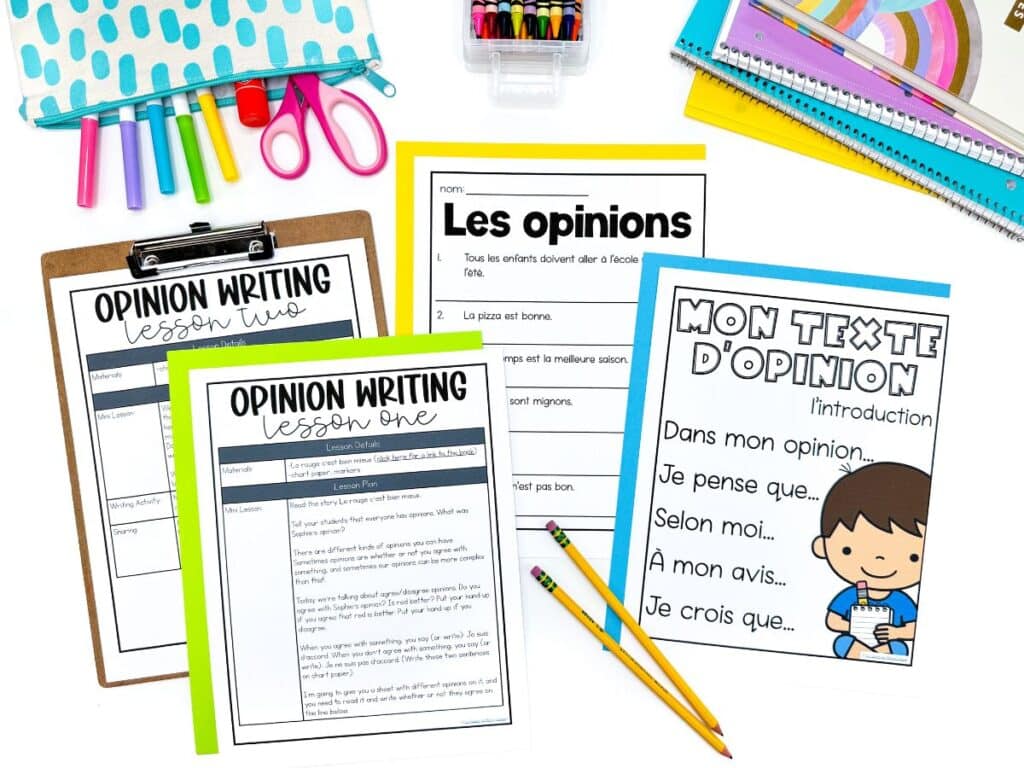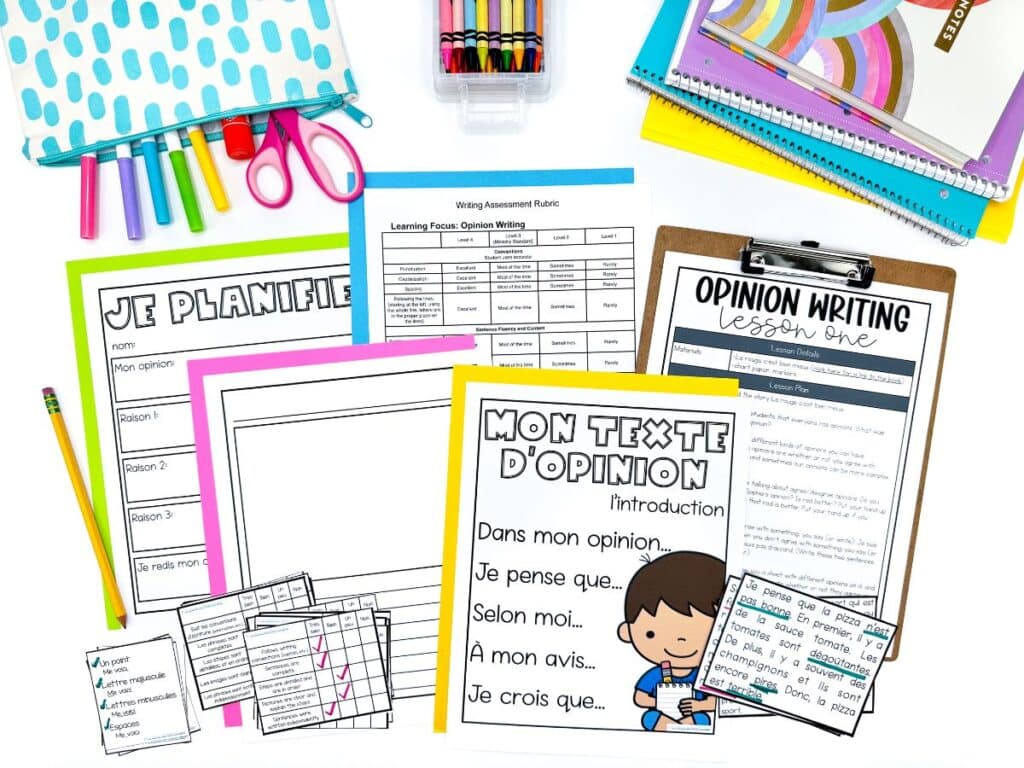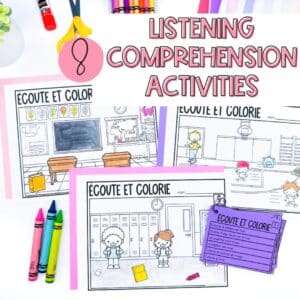
How to Teach Opinion Writing in French in 5 Easy Steps
Some teachers struggle with knowing how to teach opinion writing in French to their students effectively. An opinion writing unit is a fantastic way to help students develop their voices and express their thoughts in a meaningful way. We all have opinions—now it’s time to give your students the tools to share theirs in French!
But before diving in, it’s important to lay the groundwork. A strong start begins with key vocabulary and oral practice, helping students learn how to express their opinions clearly. Building these skills through discussion makes the transition to writing much smoother.
Of course, teaching in a second language adds an extra challenge, but practice makes perfect! If students can articulate their opinions verbally, they’ll be much more confident when putting their thoughts on paper. A writer’s workshop approach is an excellent way to scaffold this process—here’s why you should be using one in your classroom.
This unit is highly engaging, giving students the chance to showcase their personalities and perspectives. Let’s break down how to teach it effectively!

How to Teach Opinion Writing in French
Step 1. Expressing an Opinion
The first step in teaching French opinion writing focuses on expressing opinions, an essential skill for effective communication. Start by having students share their views on simple topics, either orally or in writing. For instance, prompt them with statements like, “Pizza is good. Agree or disagree?” This introduces the fun and ease of stating a clear stance.
As students get more comfortable, they move to more complex questions that require more than yes or no answers, such as, “What is the best season, and why?” These questions encourage deeper reflection and more detailed language use.
Throughout these exercises, incorporate crucial vocabulary needed for opinion writing. Teach them opinion writing prompts like “Je pense que…” to help structure their thoughts. This approach builds a solid foundation, preparing students to express their opinions confidently in both spoken and written French.
Step 2. Make Lists
It’s important to realize that we have opinions about many things, often without even noticing. You might think that wind is the worst kind of weather or that no breakfast is complete without a glass of orange juice. Students might also have opinions about more complex topics, like how the school should be run.
Have your students create a list of topics on which they have opinions. These can range from simple everyday choices, like the best breakfast food, to more complex subjects. In this list, they should only name the topics without including their opinions. This exercise is useful when they need ideas for practicing opinion writing and aren’t sure what to write about.

Step 3. Planning What You Want to Say
It’s crucial to plan your words carefully to communicate your opinion effectively. I recommend using graphic organizers as a tool to map out your main opinion, followed by three supporting reasons during your entire writing unit. It’s a clear, visual way to structure thoughts before diving into the writing itself.
After laying out your reasons, remember to restate your opinion at the end, but try to phrase it differently to reinforce your point without sounding repetitive. Also, don’t forget to equip your students with the necessary sentence stems for each part of their piece—the introduction, the reasons for their opinion, and the conclusion.
For a practical example, take a look at the book “Le Rouge C’est Bien Mieux.” Each time Sophie prefers the red item over another, she provides a clear reason, making it an excellent model for structuring reasoned arguments. This method not only helps in organizing thoughts but also in making the opinion piece more persuasive and coherent.

Step 4. Adding Examples
After you’ve listed your reasons for your opinion, complement each one with concrete examples. This step is crucial as examples make your argument more persuasive and relatable. Encourage students to use personal experiences, historical facts, or hypothetical scenarios.
For instance, if arguing that “summer is the best season,” they could mention experiences like beach vacations, enjoying outdoor festivals, or the freedom felt during school breaks. These specific instances help solidify their opinions and engage the reader.
Step 5. Try It Out!
Alright, your students have done all the legwork: they’ve shared their opinions, mapped out their arguments, and backed up their points with reasons and examples. Now, it’s time to bring it all together and craft a full paragraph.
This part should feel like a breeze since they’re well-prepped with all the necessary background info. Encourage them to let their ideas flow into a well-structured paragraph, reminding them that this is where all their planning pays off.
Once they’ve got their draft down, it’s editing time. Sit down with them to tweak and polish. Help them smooth out any rough edges and finalize a polished version. It’s a great chance to show them how refining their work can really make their opinions shine. Plus, it’s super satisfying to see their developed thoughts come together in a neat, persuasive package.

Final Thoughts
Remember, the key to teaching effectively is to model, model, model. Demonstrate everything you expect from your students—articulate your thoughts clearly, spell out unfamiliar words, and walk them through each step of the writing process.
My students go through this entire process multiple times. In the end, they select the piece they’re most proud of, enrich it with more details, and then I step in to help them polish it. They only create a good copy of this chosen text, and that’s the one I assess. It’s crucial to adjust the complexity based on your students’ levels; not everyone may be ready for three reasons or examples. Sometimes, a simple “I think *** because ***” is enough.
You don’t have to do all the hard work planning out a unit yourself. I’ve created a low prep, ready-to-go French opinion writing unit, complete with lesson plans and assessments that you can use in your classroom today.
Recommended products
You might also like...
find what you need
Browse by Category
Looking to do some phonics based shared reading?




